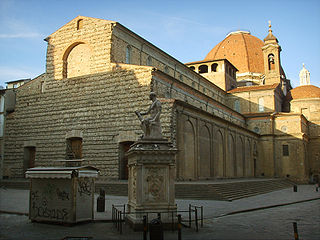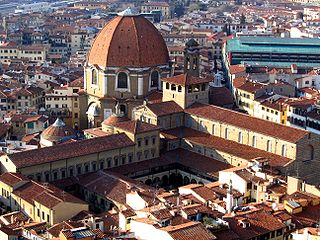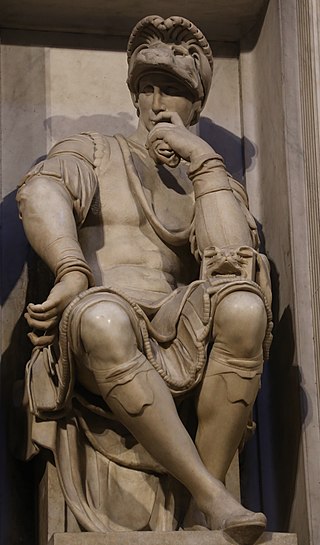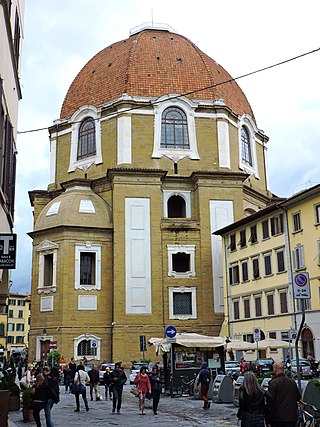
Michelangelo di Lodovico Buonarroti Simoni, known mononymously as Michelangelo, was an Italian sculptor, painter, architect, and poet of the High Renaissance. Born in the Republic of Florence, his work was inspired by models from classical antiquity and had a lasting influence on Western art. Michelangelo's creative abilities and mastery in a range of artistic arenas define him as an archetypal Renaissance man, along with his rival and elder contemporary, Leonardo da Vinci. Given the sheer volume of surviving correspondence, sketches, and reminiscences, Michelangelo is one of the best-documented artists of the 16th century. He was lauded by contemporary biographers as the most accomplished artist of his era.

Filippo di ser Brunellesco di Lippo Lapi, commonly known as Filippo Brunelleschi and also nicknamed Pippo by Leon Battista Alberti, was an Italian architect, designer, goldsmith and sculptor. He is considered to be a founding father of Renaissance architecture. He is recognized as the first modern engineer, planner, and sole construction supervisor. In 1421, Brunelleschi became the first person to receive a patent in the Western world. He is most famous for designing the dome of the Florence Cathedral, and for the mathematical technique of linear perspective in art which governed pictorial depictions of space until the late 19th century and influenced the rise of modern science. His accomplishments also include other architectural works, sculpture, mathematics, engineering, and ship design. Most surviving works can be found in Florence.

Lorenzo di Piero de' Medici was the ruler of Florence from 1516 until his death in 1519. He was also Duke of Urbino during the same period. His daughter Catherine de' Medici became Queen Consort of France, while his illegitimate son, Alessandro de' Medici, became the first Duke of Florence.

The Basilica di Santa Croce is a minor basilica and the principal Franciscan church of Florence, Italy. It is situated on the Piazza di Santa Croce, about 800 metres southeast of the Duomo, on what was once marshland beyond the city walls. Being the burial place of some of the most notable Italians, such as Michelangelo, Galileo, Machiavelli, the poet Foscolo, the philosopher Gentile and the composer Rossini, it is also known as the Temple of the Italian Glories.

San Miniato al Monte is a basilica in Florence, central Italy, standing atop one of the highest points in the city. It has been described as one of the finest Romanesque structures in Tuscany and one of the most scenic churches in Italy. There is an adjoining Olivetan monastery, seen to the right of the basilica when ascending the stairs.

The Basilica di San Lorenzo is one of the largest churches of Florence, Italy, situated at the centre of the main market district of the city, and it is the burial place of all the principal members of the Medici family from Cosimo il Vecchio to Cosimo III. It is one of several churches that claim to be the oldest in Florence, having been consecrated in 393 AD, at which time it stood outside the city walls. For three hundred years it was the city's cathedral, before the official seat of the bishop was transferred to Santa Reparata.

Michelozzo di Bartolomeo Michelozzi was an Italian architect and sculptor. Considered one of the great pioneers of architecture during the Renaissance, Michelozzo was a favored Medici architect who was extensively employed by Cosimo de' Medici. He was a pupil of Lorenzo Ghiberti in his early years, and later collaborated with Donatello.

The Pazzi Chapel is a chapel located in the "first cloister" on the southern flank of the Basilica di Santa Croce in Florence, Italy. Commonly credited to Filippo Brunelleschi, it is considered to be one of the masterpieces of Renaissance architecture.

The Medici Chapels are two chapels built between the 16th and 17th centuries as an extension to the Basilica of San Lorenzo in Florence, Italy. They are the Sagrestia Nuova, designed by Michelangelo; and the larger Cappella dei Principi, a collaboration between the Medici family and architects. The purpose of the chapels was to celebrate the Medici family, patrons of the church and Grand Dukes of Tuscany.

Don Giovanni de' Medici (13 May 1567, in Florence – 19 July 1621, in Murano) was an Italian military commander, diplomat and architect.

The Sagrestia Vecchia di San Lorenzo, or Old Sacristy of San Lorenzo, is the older of two sacristies of the Basilica of San Lorenzo in Florence, Italy. It is one of the most important monuments of early Italian Renaissance architecture. Designed by Filippo Brunelleschi and paid for by the Medici family, who also used it for their tombs, it set the tone for the development of a new style of architecture that was built around proportion, the unity of elements, and the use of the classical orders. The space came to be called the "Old Sacristy" after a new one was begun in 1510 on the other side of S. Lorenzo's transept.
Matteo Nigetti was an Italian architect and sculptor. He is an important Baroque architect in Florence.

Bicci di Lorenzo (1373–1452) was an Italian painter and sculptor, active in Florence.

Michelangelo had a complicated relationship with the Medici family, who were for most of his lifetime the effective rulers of his home city of Florence. The Medici rose to prominence as Florence's preeminent bankers. They amassed a sizable fortune some of which was used for patronage of the arts. Michelangelo's first contact with the Medici family began early as a talented teenage apprentice of the Florentine painter Domenico Ghirlandaio. Following his initial work for Lorenzo de' Medici, Michelangelo's interactions with the family continued for decades including the Medici papacies of Pope Leo X and Pope Clement VII.

The Portinari Chapel is a Renaissance chapel at the Basilica of Sant'Eustorgio, Milan, northern Italy. Commenced in 1460 and completed in 1468, it was commissioned by Pigello Portinari as a private sepulchre and to house a silver shrine given by Archbishop Giovanni Visconti in 1340 containing the relic head of St. Peter of Verona, to whom the chapel is consecrated. The architect is unknown, the traditional attribution to Michelozzo having been succeeded with equal uncertainty by attributions to either Filarete or Guiniforte Solari, architect of the apses of the Certosa di Pavia and the church of San Pietro in Gessate in Milan.

The Medici Madonna is a marble sculpture carved by the Italian Renaissance master Michelangelo Buonarroti measuring about 88.98 inches in height. Dating from 1521 to 1534, the sculpture is a piece of the altar decoration of the Sagrestia Nuova in the Basilica of San Lorenzo, Florence.

Alessandro Pieroni was an Italian architect and painter. He was active mainly in a Mannerist style, working for the courts of Grandukes Francesco I and Ferdinando I de' Medici, Grand Duke of Tuscany.
Andrew Dermot Morrogh is a British art historian and academic. He has taught in the United States at the University of Oregon College of Design and assistant at the Department of Art History at the University of Chicago. He has published several books and articles on the art and architecture of the Italian Renaissance. Among his publications is the catalogue of an exhibition he organised for the Uffizi, Disegni di Architetti Fiorentini 1540–1640 (1985).

Cappella dei Principi is the mausoleum of the Grand Dukes of Tuscany and their families and is part of the museum complex of the Medici Chapels of Florence, adjacent to the Basilica di San Lorenzo

The Sagrestia Nuova, also known as the New Sacristy in English, is a mausoleum that stands as a testament to the grandeur and artistic vision of the Medici family. Constructed in 1520, the mausoleum was designed by the Italian artist Michelangelo. Situated adjacent to the Basilica di San Lorenzo in Florence, Italy, the Sagrestia Nuova forms an integral part of the museum complex known as the Medici Chapels.

















